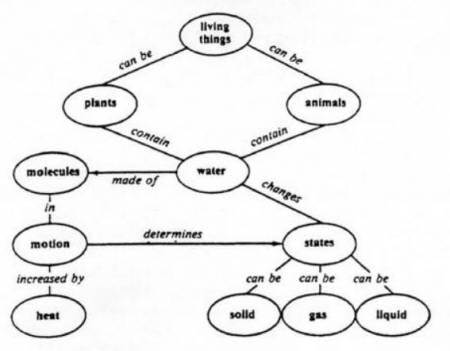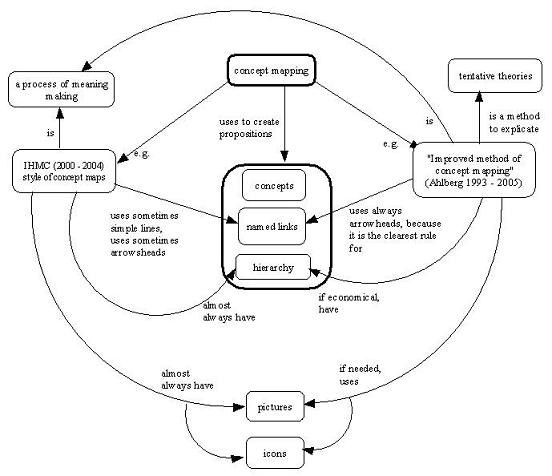Table of Contents
Concept Mapping
General
Concept mapping is a cognitivist instructional design model developed by Joseph Novak and his colleagues in 1972 as they worked on understanding how children's knowledge of science changes1). Some of the first concept maps were, however, proposed by some other authors as well2), but concept maps in their fullest form were introduced by Novak in 19813). In Novak's words, concept map is a
- “visual representation of the relationships between concepts held by an individual, materials of a lecture, textbook, or laboratory exercise. By concept mapping even old and familiar material, we often recognize new relationships and meaning.”4)
Novak's ideas were influenced by David Ausubel's assimilation theory and his hierarchical knowledge structure suggestions5).
What is concept mapping?
Concept mapping is the process of creating concept maps,
- “graphical tools for organizing and representing knowledge. They include concepts, usually enclosed in circles or boxes of some type, and relationships between concepts indicated by a connecting line linking two concepts. Words on the line, referred to as linking words or linking phrases, specify the relationship between the two concepts. We define concept as a perceived regularity in events or objects, or records of events or objects, designated by a label.”6)
As explained, on the visual level, a concept map is a hierarchical (general to specific) diagram containing nodes and links, both labeled with words or symbols. The most important concept is usually placed in the center of the map or at its top. Novak describes the concept map building process in following steps7):
| 1. | Identify key concepts of the material and list them or write them on pieces of paper to make them movable. |
|---|---|
| 2. | Rank concepts by placing most general ones at the top of the map with respect to the context of the matherial. |
| 3. | Add other more specific concepts under the more inclusive ones. |
| 4. | Connect concepts by labeled lines. Labels should add meaning by defining relationships between connected concepts. |
| 5. | If desired, specific examples of concepts can also be added below concept labels. |
| 6. | If desired, change or reorganize the map in accordance with the newly noted relations between the concepts. Concept maps for the same topic can be organized in more possible ways. |
Concepts maps can be useful to both teachers and students. To students concept maps give the ability to organize and assess their own knowledge, and learn through adding new concepts to the existing framework of the concept map8). Such process of creating and learning using a concept map is, according to Novak9), often accompanied by positive feelings. A teacher can use concept maps to10):
- identify and organize concepts he is about to teach,
- gain insight to what the students already know or how they view the topic from concept maps drawn by the students,
- organize information into meaningful categories and relate those categories on a more general level,
- synthesize and integrate learned information thereby strengthening long-term retention, and
- teach terms, facts, and concepts of given topic, develop creativity and higher-level thinking skills, strategies, and habit.
A step-by-step example on how to introduce and work on concept maps with students in classes can be found in Michael Zeilik's article on concept mapping.
An important property of concept maps is that learning through adding new concept to them is inherently meaningful learning, since it establishes clear connections with the existing knowledge. Rote learning on the other hand would be the result of lack of established connections to prior knowledge and causes forgetting of the learned information in 4-6 weeks.11)12)
A set of improvements to concept mapping has been suggested by various authors including Ahlberg13):
- all concepts are interpreted as main elements and should be inside frames, which was not the case in Novak's earlier works
- there are no limits on the length of the labels since longer labels are sometimes required to offer accurate explanation
- connections should have arrowheads in order to point the direction of the connection
- pictures, videos or sounds may also be connected in a concept map
- concept mapping is a general method for knowledge representation and does not have to be associated exclusively with Ausubel's assimilation theory
- concept maps do not have to be hierarchical (for example cyclic concept maps14))
- a good concept map should have only one instance of each concept, which was not the rule in some Novak's works, sometimes due to a too large number of links connecting a certain concept
- sometimes it is useful to suggest a way of reading a concept map (for example top to bottom or bottom to top)
Concept maps were earlier drawn by hand, but today a number of computer applications like the free IHMC CmapTools can be used to enhance this process.
Criticisms
Concept mapping is a very well accepted and widely used method, but it:
- was designed mostly to represent declarative and not procedural knowledge or algorithms,
- is a rather difficult and sometimes time-consuming cognitive task which requires training, and
- there is no standardized way of scoring/comparing concept maps15).
Keywords and most important names
- Concept mapping, concept maps, concept, object, meaningful learning
Bibliography
Novak, J. D. Introduction to concept mapping.
Novak, Joseph D. & Cañas, Alberto J. The Origin and Development of Concept Maps.
Zeilik, M. Classroom Assessment Techniques: Concept Mapping.
Novak, Joseph D. & Cañas, Alberto J. The Origin and Development of Concept Mapping.

